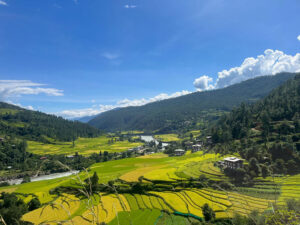Bhutan government will allow foreign workers in agriculture
Punakha—Farmers in Punakha are grappling with a confluence of challenges, from water shortages, unpredictable rainfall, and scarcity of labour to rising daily wages. The shortage of farm labourers has forced many farming households to leave their otherwise fertile agriculture land fallow.
According to the 2019 RNR Census by the National Statistics Bureau, Punakha Dzongkhag alone had 597.4 acres of fallow land.
Agricultural production has been heavily impacted by fallow lands across the country, with the harvested area for paddy shrinking from 53,055 acres in 2016 to just 23,290 acres in 2023. More than 66,000 acres of farmland remains uncultivated across the country.
Agriculture Minister Younten Phuntsho said that while many factors contribute to this problem, the shortage of farm labour is the main culprit for this troubling trend.
Lyonpo said that the Ministry of Agriculture and Livestock is implementing a series of strategic initiatives aimed at revitalising fallow land and boosting agricultural productivity.
One such initiative involves engaging day labourers from across the border for farming in the border districts to start with. This approach, Lyonpo said, will alleviate the financial burden of high domestic labour costs.
“Given the wage differences, importing cross-border labour will be more affordable,” the minister said.
Though the ministry is optimistic, it remains to be seen whether the import of seasonal foreign labour will effectively address the shortage. “We can only assess its impact post-implementation,” he added.
The Ministry will pilot the employment of seasonal day workers from this year. This decision follows consultations with relevant stakeholders, including the Ministry of Home Affairs and the Ministry of Industries, Commerce, and Employment.
A task force is being established, and a Standard Operating Procedure (SOP) is under development, which will be submitted to the Cabinet for approval.
Employing foreign labour is expected to offer several benefits that go beyond immediate productivity gains.
In 2023, Bhutan imported 93,457 metric tonnes of rice valued at Nu. 3.1 billion. By employing foreign workers, the ministry hopes to restore around 3,252 acres of fallow wetland, which could yield an estimated 5,854 metric tonnes of paddy, reducing rice imports by Nu 228 million.
The engagement of foreign labour is also expected to reduce reliance on chemical herbicides, which has increased due to the lack of domestic farm workers. This strategy is also expected to reduce rural-urban migration by addressing labour shortages and revitalising unused land.
The agriculture minister said that while allowing seasonal labour is considered for implementation as a sandbox model, the ministry is exploring other solutions, including farm mechanisation.
If the proposed JICA-ODA loan is secured, Nu 3.5 billion will be invested to procure over 14,000 agricultural machines to enhance farming efficiency.
The ministry also plans to offer concessional loan products to farmers to procure essential agricultural machinery. However, the minister cautioned that mechanisation alone cannot fully address the labor shortage, as many agricultural tasks—such as weeding, vegetable harvesting, irrigation, and packaging—still require manual intervention
Bhutan’s rugged terrain makes widespread mechanisation challenging.
To overcome these obstacles, the ministry is promoting collective farming in larger command areas, aiming to enhance economies of scale in both production and labour productivity. This collaborative approach will encourage farmers to work in groups and cooperatives, leading to increased commercial farming.
Shifting focus to high-value, low-labour crops is another strategy under consideration. Commodities such as asparagus, cardamom, and strawberries require less labour while offering greater returns compared to traditional crops like paddy.
Engaging youth in agriculture is also a key priority for the ministry.
Lyonpo said that various programmes are being developed to make farming an attractive and viable career path for young people. These initiatives include modern farming training, financial incentives, and support for agribusiness ventures.
“Through these measures, the ministry hopes to reduce rural depopulation and curb unemployment in urban areas,” the minister said.
In addition, the ministry is exploring agritech innovations to modernise Bhutanese farming, which has traditionally relied on low-tech methods. Plans include the use of drones for crop monitoring and fertilizer application. Two model farms will be established to demonstrate the latest in modern agricultural techniques.





